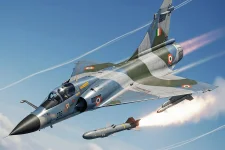- Views: 2K
- Replies: 10

Brazil has expressed strong interest in acquiring the BrahMos-NG (Next Generation) supersonic cruise missile, a cutting-edge weapon system jointly developed by India and Russia.
With its Mach 3 speed and compact design, the BrahMos-NG is being considered as a potential armament for Brazil's Gripen-E fighter fleet. This missile, currently under development by BrahMos Aerospace, is garnering international attention due to its unique blend of speed, size, and versatility.
The BrahMos-NG is a miniaturized version of the highly successful BrahMos supersonic cruise missile. Weighing just 1.3 tons, it is comparable in size to many subsonic cruise missiles, yet capable of travelling at three times the speed of sound. This combination provides a significant tactical advantage.
Its Mach 3 velocity makes it extremely difficult to intercept with current-generation air defence systems. Unlike subsonic cruise missiles, which are increasingly vulnerable to interception, the BrahMos-NG's high speed ensures it can reach its target before adequate countermeasures can be deployed.
The missile's compact size allows for integration with a wider range of platforms, including non-Russian aircraft like the Saab Gripen-E, a key factor driving interest from Brazil. With a strike range of 290 kilometers, the BrahMos-NG is well-suited for precision strikes on high-value targets, making it an attractive option for modern air forces seeking to enhance their offensive capabilities.
The ongoing conflict in Ukraine has further highlighted the vulnerabilities of subsonic cruise missiles, even those with stealth capabilities. As advanced air defence systems become more prevalent, the need for faster, more survivable options like the BrahMos-NG becomes increasingly critical.
India's own Air Force (IAF) has strongly backed the BrahMos-NG program and is positioned to be the missile's first customer. The initial variant under development is an air-launched version optimized for integration with fighter jets like the Su-30MKI, Tejas Mk1A and MkII, and potentially the Gripen-E.
According to BrahMos Aerospace, developmental trials of the BrahMos-NG are expected to commence by 2026, with the missile becoming operational shortly thereafter. The IAF's support for the program underscores its strategic significance and provides confidence to potential international buyers like Brazil.
BrahMos Aerospace, which recently opened a new facility in Lucknow, plans to utilize this facility for the production of the BrahMos-NG once it is cleared for production. This expansion of production capacity will be crucial in meeting both domestic and international demand for this promising new missile system.



